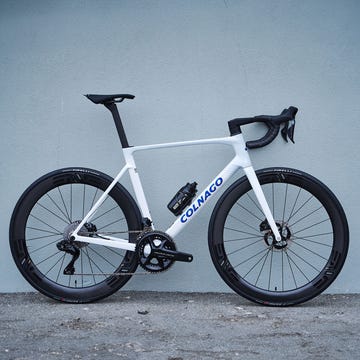One of the most signifcant cycling equipment trends in recent history is the move toward wider tires.
As always, finding a single reason that sparked this trend is almost impossible, but there are people and technologies that deserve at least partial credit.
However, a retrospective study of the wide tire trend is needed at a different time. Wider tires are here, and you have questions.
Below is a breakdown of six things you should consider when shopping for wider tires. As you can probably guess, you can’t just put any fat tire on any bike. Plus, there’s a host of other considerations to ponder that you may not have contemplated, including: Will wider tires negatively affect my bike?
1. Frame Clearance
Let’s start with the one thing that most decides what width tires you can ride: Your bike. Every frame has physical limitations that dictate how wide a tire will fit. But it’s not as simple as the literal inner width of the fork or chain stays.
Government regulations mandate that bikes have a certain amount of free space around the tire. This free space allows any debris picked up by the tire to pass through unimpeded, reducing the chances of sudden wheel lockups caused by something jamming between the frame (or fork) and the tire.
Most brands adhere to the International Organization for Standardization (ISO) rules, which are a minimum of four to six millimeters (depending on bicycle type) of clearance around the tire.
So, when a brand states a bike’s tire clearance—for example, Specialized says the Roubaix SL8’s tire clearance is 40mm—it is with ISO rules considered.
And a quick heads up: Sometimes, a bike’s frame and fork have different clearances.
Tire clearance is not created in isolation but is inexorably tied to many other factors. With rim brake bikes, the brake caliper is often the limiting factor. That’s why almost all bikes designed for short-reach brakes—Shimano Dura-Ace, SRAM Red, and the like—are usually limited to 28mm tires. Different styles of rim brakes—cantilever, long reach—offer more tire clearance.
The adoption of disc brakes removed the literal pinch point of the rim brake. However, there are still other elements that influence tire clearance. Many of them have to do with a bike’s purpose and geometry. Things like geometry, frame stiffness, and aerodynamics influence the dimensions and shape of a frame.
For example, Short chain stays influence a bicycle’s handling and feel (and can play a role in frame weight and stiffness), but it’s hard to make a race bike with short chain stays and meet ISO clearance standards that fits a big tire.
Because the ISO standards are considered in the dimensions, most disc brake frames fit a wider tire than manufacturers’ clearance lists. Over-tiring (running a tire wider than the frame’s listed maximum) a bike might be fine if you ride exclusively in dry and clean conditions; however, it is a bad idea in wet and muddy conditions.
No matter the conditions, be very cautious if you’re over-tiring a bike. The clearance is there for a reason: Too wide a tire can lead to frame damage—from a dirty tire rubbing against the frame—or a loss of control and crashes.
2. A tire’s advertised width may not be the same as its actual width
A tire may say 32 on its sidewall, but that doesn’t mean that it will be precisely 32mm wide when mounted on a rim and inflated. A tire’s actual width—which some call Width As Measured (WAM)—is influenced by the internal width of the rim it’s mounted to, tire pressure, and sometimes by the internal shape of the rim (hooked or hookless).
Tire manufacturers can’t consider every rim and potential tire pressure, so a tire’s advertised width is a little bit theoretical.
A big reason is that tire manufacturers have a special rim—called a design rim or measuring rim—that they use to measure a tire when determining its labeled size. This rim’s width is often (but not always) in the middle of the ETRTO’s coupling chart for a given tire size.
According to that chart, a 32mm tire should be coupled with a 16 to 25mm (internal width) rim. So, the design, or measuring, rim should be around 21mm.
However, the measuring rim width does not change for every tire size. One brand told me that it uses a 21mm design rim width for its 29 to 34mm width road tires. So, its road tires labeled 29 to 34mm should measure exactly that, but only on a 21mm rim.
According to Continental, “For clincher tires, the width will be affected by 0.4 mm for each millimeter your rim width differs from Continental’s measuring rim.”
Using my 32mm tire example (16 to 25mm rim), that’s a tire width range of about 3.6mm, or +/- 1.8mm(ish) for a tire labeled 32 (if you stick within ETRTO coupling standards).
And just to make things more frustrating and confusing, not every brand uses the same design or measuring rim width per tire size. Continental, for example, uses a 15mm measuring rim for its 25-labeled tires. A different brand told me that they use a 19mm measuring rim for its 25-labeled tires.
That’s why one brand’s 25mm tire may not be the same width as another brand’s 25mm tire, even measured on the same rim.
Tire pressure can also make a small difference in tire size, so it is important to note that brands measure a tire’s size not only on their design/measuring rim but also at the tire’s maximum inflation pressure. At a tire’s optimal pressure, it might be a bit narrower.
But tires do stretch a bit over time, so they’ll be wider—likely just slightly so—later in their life than they were when new.
3. Your Wheels
As described above, the internal width of your rims, along with their design—hooked or straight side (AKA hookless)—influence the measured width of your tires. But there are a couple other things to know about your wheels and tire width.
One is that you’re supposed to consider the internal width of your rims when picking a tire size. For example, According to ETRTO standards, a 28mm tire should be matched to an internal rim width of 15 to 23mm, while a 32mm tire should be matched to a 16 to 25mm internal width.
These coupling standards are expansive, so unless you’re doing some crazy mashups of wheels and tires, they are largely academic when using mainstream equipment.
While I’ve referenced internal width quite a bit, you may also want to consider the external width of your wheels. That’s because the lowest aerodynamic drag is realized when your tire’s actual (when mounted and inflated) width is about the same as your rim’s external width.
4. Standards Hijinks
In theory, the ETRTO and ISO standards are a set of dimensions that all parties agree to use to ensure compatibility and prevent confusion.
Reality is more complex.
Standards change, which means that something that was compatible with the old standards is now considered incompatible with the updated standards.
For example, previously, the ETRTO said that it was okay to pair a 28mm tire on a 25mm (internal width) rim. However, a recent update to the standards now indicates that 23mm is the widest rim compatible with a 28mm tire.
And then some brands eschew the standards. For example, Zipp's 303 XPLR wheel. According to ETRTO, the appropriate tire widths for a 32mm (internal width) rim are 58 to 83mm. Zipp, however, states 40mm minimum to 60mm maximum tire widths for the 303 XPLR.
I asked Zipp about this discrepancy and have not received a response yet.
5. The Typical Surface You Ride
“Wider tires are faster” is short, sweet, and seemingly straightforward. But nothing with tires is that straightforward.
Essentially, the rougher the surface you ride, the more a wider and softer tire is advantageous. That’s one reason why track bikes—which are raced on hyper-smooth surfaces—still roll on narrow, high-pressure tires.
But that’s just considering rolling resistance. When we ride our bikes, we’re fighting against more than just rolling resistance.
If we consider that surface roughness often correlates to average speed—you ride faster on smooth surfaces and slower on rough surfaces—we also need to talk about aerodynamics.
A basic tenant of aero drag is that the faster you go, the more aerodynamics matter. And wider tires have more frontal area (tread pattern also influences drag). But as I mentioned, the width of the rim a tire is mounted on influences drag. With the same rim, different tires, and different tire widths, might produce different drag numbers. The reverse is also true: The same tire may return different drag numbers depending on the rim it’s mounted on.
You can see that there is a whole mess of surface roughness, speed and aero drag, and equipment combinations to consider. Now, mix in that most rides encompass a variety of speeds and surface conditions, and you can see why blanket statements like “Wider tires are faster” don’t do justice to a very complex topic. And we haven’t even discussed air pressure, casing construction, and rubber compound yet.
Frankly, we’re still learning how tire width, in combination with surface roughness, aerodynamics, and other elements, affect efficiency and how to weigh all the different factors to make the best equipment decision for a given situation.
The takeaway is if you mostly ride on good tarmac and at higher speeds, a wider tire might not be much faster than a narrower tire. It may, depending on the various factors involved, even be slower.
But if you primarily ride on rough surfaces, the widest tire you can fit in your frame might be the fastest.
6. How you like your bike to feel
I think how you like your bike to feel gets lost in all the nerd talk about wider tires.
Narrower tires at higher pressure make a bike feel crisper, and there is more feedback from the road. So what if your bike is slower because of those narrow and high-pressure tires? Ride what you like.
One thing that I struggle with is how a wide and lower-pressure tire can feel under high cornering loads on tarmac. There can be noticeable wallowing and casing deformation, which I find vague and disconcerting, and I don’t love the way a softer tire generates a tugging sensation at the bars.
The way to offset this is to put more air in the tires. But then they don’t roll as smoothly, which is one of the benefits of a wider tire.
Changing tire size also influences a bike’s geometry and handling characteristics. While I think a lot of this influence falls below a just noticeable difference, some riders are extremely sensitive and picky. If you’re one of them, it’s worth considering what changing tire size might do to your bike.

A gear editor for his entire career, Matt’s journey to becoming a leading cycling tech journalist started in 1995, and he’s been at it ever since; likely riding more cycling equipment than anyone on the planet along the way. Previous to his time with Bicycling, Matt worked in bike shops as a service manager, mechanic, and sales person. Based in Durango, Colorado, he enjoys riding and testing any and all kinds of bikes, so you’re just as likely to see him on a road bike dressed in Lycra at a Tuesday night worlds ride as you are to find him dressed in a full face helmet and pads riding a bike park on an enduro bike. He doesn’t race often, but he’s game for anything; having entered road races, criteriums, trials competitions, dual slalom, downhill races, enduros, stage races, short track, time trials, and gran fondos. Next up on his to-do list: a multi day bikepacking trip, and an e-bike race.



















